

Reefs at Risk in Southeast Asia. How to Reduce Your Coral Reef Footprint. Are Coral Reefs Adapting to Moderate Climate Change? A recent modeling study shows that widespread bleaching events, like this one in Thailand in 2010, will become more common in the future.
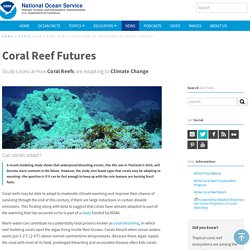
However, the study also found signs that corals may be adapting to warming—the question is if it can be fast enough to keep up with the rate humans are burning fossil fuels. Coral reefs may be able to adapt to moderate climate warming and improve their chance of surviving through the end of this century, if there are large reductions in carbon dioxide emissions. This finding along with data to suggest that corals have already adapted to part of the warming that has occurred so far is part of a study funded by NOAA. Warm water can contribute to a potentially fatal process known as coral bleaching, in which reef-building corals eject the algae living inside their tissues. Corals bleach when ocean waters warm just 1-2°C (2-4°F) above normal summertime temperatures.
Coral Triangle. Climate change is a global problem - and one we can all help tackle. Last updated 05:00, March 31 2018 Caption Settings Dialog Beginning of dialog window.

Climate Change - Australian Marine Conservation Society. Effects of global warming on our oceans - WWF-Australia. 5 ways climate change is affecting our oceans. Editor’s note: This post was updated on Aug. 23, 2018 Climate change is taking a toll on forests, farms, freshwater sources and the economy – but ocean ecosystems remain the epicenter of global warming. Even with their vast capacity to absorb heat and carbon dioxide, oceans were 0.17 degrees Celsius (0.3 degrees Fahrenheit) warmer in 2017 than in 2000, and the warming trend appears to be accelerating. More than 90 percent of Earth’s warming since 1950 occurred in oceans, so it’s easy to see why scientists are concerned. Here are five ways these ever-warmer temperatures are affecting our oceans: 1. As early as 1990, coral reef expert Tom Goreau and I pointed out that mass coral bleaching events observed during the 1980’s were probably due to anomalously warm temperatures related to climate change.
It’s now evident that many coral reefs, including Australia’s Great Barrier Reef, are dying. Coral reefs are particularly sensitive to increases in temperature. 2. 3. 4. 5. Ocean warming. Ocean warming leads to deoxygenation – a reduction in the amount of oxygen dissolved in the ocean – and sea-level rise – resulting from the thermal expansion of sea water and continental ice melting.
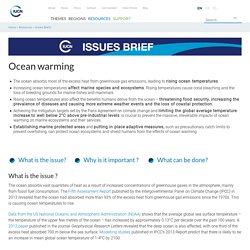
The rising temperatures, coupled with ocean acidification (the decrease in pH of the ocean due to its uptake of CO2), affect marine species and ecosystems and, consequently, the fundamental benefits humans derive from the ocean. Photo: The consequences of excess heat from greenhouse gas emissions. Redrawn and modified after von Schuckmann et al. (2016). Goal 14. The global indicator framework was developed by the Inter-Agency and Expert Group on SDG Indicators (IAEG-SDGs) and agreed to, as a practical starting point at the 47th session of the UN Statistical Commission held in March 2016. The report of the Commission, which included the global indicator framework, was then taken note of by ECOSOC at its 70th session in June 2016.
More information. By 2025, prevent and significantly reduce marine pollution of all kinds, in particular from land-based activities, including marine debris and nutrient pollution. Land-based activities — Marine. Land-based activities and industries can affect marine ecosystems in a variety of ways.
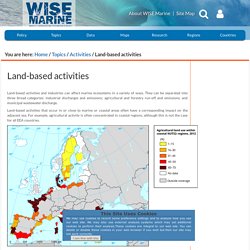
They can be separated into three broad categories: industrial discharges and emissions; agricultural and forestry run-off and emissions; and municipal wastewater discharge. Land-based activities that occur in or close to marine or coastal areas often have a corresponding impact on the adjacent sea. For example, agricultural activity is often concentrated in coastal regions, although this is not the case for all EEA countries. Source. Climate Change. Climate Change. Water Ecosystems – Saltwater. The saltwater, or marine ecosystem has a large salt composition compared to freshwater, and covers nearly half of the earth.
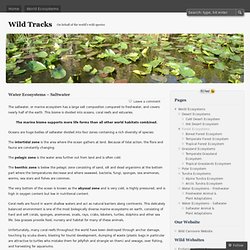
This biome is divided into oceans, coral reefs and estuaries. The marine biome supports more life forms than all other world habitats combined. Climate Change. Climate Change. Oceans. Global Warming. Oceans. Océans. Climate change by state. Climate change. Climate Change. Key Points After a period of approximately 2,000 years of little change (not shown here), global average sea level rose throughout the 20th century, and the rate of change has accelerated in recent years. 1 When averaged over all the world's oceans, absolute sea level increased at an average rate of 0.07 inches per year from 1880 to 2011 (see Figure 1).
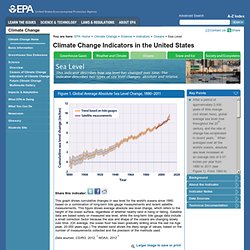
From 1993 to 2011, however, average sea level rose at a rate of 0.11 to 0.13 inches per year—roughly twice as fast as the long-term trend. Relative sea level rose along much of the U.S. coastline between 1960 and 2012, particularly the Mid-Atlantic coast and parts of the Gulf coast, where some stations registered increases of more than 8 inches (see Figure 2). Meanwhile, relative sea level fell at some locations in Alaska and the Pacific Northwest. At those sites, even though absolute sea level has risen, land elevation has risen more rapidly.
Background As the temperature of the Earth changes, so does sea level. Climate Change. Saltwater ecosystem. Oceanic climate. World map showing oceanic climate zones, as defined by the Köppen climate types "Cfb", "Cfc", "Cwb" and "Cwc". Under the Köppen climate classification, the typical zone associated with the Oceanic climate is Cfb, although it includes subtropical highland zones not usually associated with marine climates. Often, parts of the Csb Mediterranean or Dry-Summer subtropical zones are not associated with a typical Mediterranean climate, and would be classified as Temperate Oceanic (Cfb), except dry-summer patterns meet Koeppen's minimum Cs thresholds. Other climate classification systems, such as Trewartha, place these areas firmly in the Oceanic zone (Do).[1] Properties[edit] Climates near the ocean generally have warm (but not hot) summers, and cool (but not cold) winters.
Saltwater ecosystem. Sea climate. Sea plants. Sea climate. Global Warming. Top 10 Facts About Salt Water Ecosystem. A Student's Guide to Global Climate Change. Pacific Ocean. WWF: Climate change. Carbon dioxide, or CO2, is the most significant of the gases in our atmosphere which keep the Earth warm. 4 billion years ago its concentration in the atmosphere was much higher than today - 80% compared to today's 0.03%.
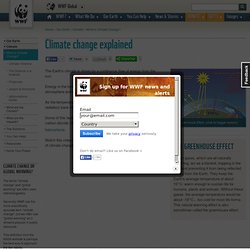
But most of it was removed through photosynthesis over time. All this carbon dioxide became locked in organisms and then minerals such as oil, coal and petroleum inside the Earth's crust. A natural carbon dioxide cycle keeps the amount of CO2 in our atmosphere in balance. Decaying plants, volcanic eruptions and the respiration of animals release natural CO2 into the atmosphere, where it stays for about 100 years. The Guardian: Climate Change. What is global warming? Clean Air Kids: Greenhouse Effect & Global Warming. The Earth is wrapped in a blanket of air called the 'atmosphere', which is made up of several layers of gases.

The sun is much hotter than the Earth and it gives off rays of heat (radiation) that travel through the atmosphere and reach the Earth. The rays of the sun warm the Earth, and heat from the Earth then travels back into the atmosphere. WWF: Climate Change. Shop to Support WWF Shop at AmazonSmile to support our global conservation efforts every time you buy.
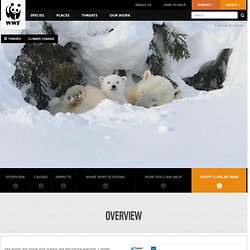
It’s the same Amazon.com you know—same products, same prices—and 0.5% of each purchase price is donated back to WWF. Is Global Warming Unstoppable? - University of Utah News Release: November 22nd, 2009. Is Global Warming Unstoppable?
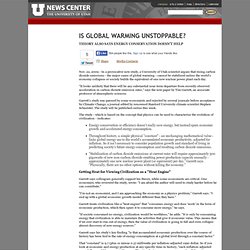
Theory Also Says Energy Conservation Doesn't Help Nov. 22, 2009 - In a provocative new study, a University of Utah scientist argues that rising carbon dioxide emissions - the major cause of global warming - cannot be stabilized unless the world's economy collapses or society builds the equivalent of one new nuclear power plant each day. "It looks unlikely that there will be any substantial near-term departure from recently observed acceleration in carbon dioxide emission rates," says the new paper by Tim Garrett, an associate professor of atmospheric sciences.
Garrett's study was panned by some economists and rejected by several journals before acceptance by Climatic Change, a journal edited by renowned Stanford University climate scientist Stephen Schneider. The study will be published online this week. The coming climate panic? One morning in the not too distant future, you might wake up and walk to your mailbox. The newspaper is in there and it’s covered with shocking headlines: Coal Plants Shut Down! Airline Travel Down 50 Percent! New Federal Carbon Restrictions in Place!
Governor Kicked Out of Office for Climate Indolence! Sometimes change is abrupt and unsettling. Shaking your head, you think: What just happened? With a non-binding agreement coming out of Copenhagen at the same time that atmospheric CO2 creeps above 390 parts per million, it’s possible that a new feeling might soon gain prevalence in the hearts of people who understand climate science. Climate change. Causes and Effects of Climate Change. NASA: Climate Change and Global Warming. What is climate change? Climate Change: What Do Scientists Say? The climate-change experiment.